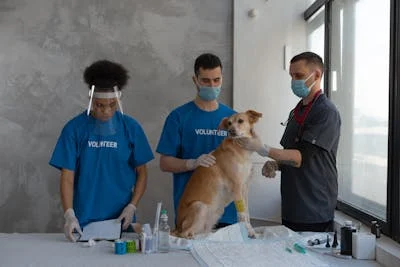Tykes are curious brutes, and occasionally they get into effects they shouldn’t. However, it’s natural to feel terrified if your dog ate silica packet. These small packets, frequently set up in shoe boxes, electronics, and food packaging, contain silica gel globules that absorb humidity. While they’re pronounced “Do Not Eat,” most silica packets are non-toxic. still, the implicit pitfalls of choking, intestinal blockages, or exposure to dangerous chemicals make it essential to address the situation snappily.
Is Silica Gel Dangerous for tykes?

Silica gel itself is considered inert and non-toxic, meaning it doesn’t reply chemically in a canine’s stomach. Still, that doesn’t mean it’s fully inoffensive. For lower tykes , the size of the packet may pose a choking threat or lead to a blockage in their digestive system. also, some packets are treated with chemicals, similar as cobalt chloride, which could be dangerous if ingested. Understanding the implicit troubles will help you take applicable way to cover your pet.
Symptoms to Watch For After Ingestion
- After your canine consumes a silica packet, it’s pivotal to cover them nearly for any unusual signs. Common symptoms include puking, diarrhea, inordinate drooling, or loss of appetite.
- Abdominal pain, restlessness, or signs of dehumidification, like a dry nose or sunken eyes, might also indicate an issue.
- However, it’s time to take action, If your canine exhibits any of these symptoms. Indeed if no symptoms appear, staying watchful for 24 – 48 hours is important.
What Should You Do If Your Canine Ate a Silica Packet?
Still, your first step is to identify the type of packet they consumed, If your canine ingests a silica packet. Check for markers or warnings, as some packets contain added chemicals. Next, remove any remaining pieces to help farther ingestion. communicate your veterinarian to explain what happed, give details about your canine’s size and age, and follow their advice. In utmost cases, stagers may recommend covering your canine at home, but in more severe situations, they might suggest a visit.
When is it necessary to contact veterinarian?

Call your veterinarian directly if your dog ate silica packet, exploits choking, patient vomiting, or shows gesticulations of an intestinal blockage. Symptoms like languor, bloating, or difficulty defecating should also prompt a visit. A quick response can significantly impact your canine’s recovery and help prevent complications.
How to help When Dog Ate Silica Packet?
Prevention plays a crucial part in keeping your canine safe. To stop your furry friend from eating silica packets, always dispose of them duly in a sealed trash can. Be aware of where you leave products containing these packets, similar as shoe boxes or food holders, and store them out of your canine’s reach. Training your canine to observe commands like “ leave it ” or “ drop it ” can also be largely effective in avoiding accidental ingestion.
Why Are tykes Attracted to Silica Packets?
tykes are naturally curious and explore their terrain with their mouths, making silica packets a tempting target. The crinkly texture and small size make these packets fun to bite on, especially for puppies. also, some silica packets may carry subtle scents from the products they were packaged with, which can intrigue your pet. Understanding this geste highlights the significance of keeping dangerous particulars down from your canine.
Can Silica Packets Beget Long-Term detriment?
In utmost cases, silica packets pass through a canine’s digestive system without causing lasting detriment. still, repeated exposure or ingestion of chemically treated packets could lead to issues over time. habitual dehumidification, intestinal vexation, or difficulty absorbing nutrients might do if your canine consumes these packets constantly. Taking way to help access to silica packets ensures your canine’s long- term health.
Alternatives to poisonous Silica Packets
- Switching to pet-safe humidity absorbers is a great way to reduce pitfalls if you’re upset about silica packets in your home.
- Non-toxic options, similar as complexion- grounded or biodegradable desiccants, are safer for homes with faves .
- These druthers serve the same purpose as silica gel but are less likely to harm your canine if accidentally consumed.
Training Tips to Keep Dogs Safe

Training your canine to avoid non-food particulars can help a range of problems. Positive underpinnings are largely effective. Educate commands like “ drop it ” or “ leave it ” using treats and praise. Exercise regularly to strengthen their response, and supervise your canine during conditioning like discharging boxes. harmonious training not only keeps your pet safe but also strengthens your bond.
How to Make Your Home Dog-Proof?
Canine- proofing your home ensures a safer terrain for your pet. Start by relating areas where silica packets or other dangerous particulars might be accessible. Store these products in high or locked closets and secure trash barrels with lids. Regularly check your home for overlooked packets, especially after unboxing new particulars. A little trouble can help a lot of solicitude.
Exigency Preparedness for Canine Ingestion Incidents
Preparing for extremities can help you respond snappily if your canine eats commodity dangerous. Keep your veterinarian’s contact information handy and assemble a pet first- aid tackle. Include particulars like actuated watercolor ( only to be used under warhorse guidance), reek, and a list of common poisons. Knowing what to do in an exigency keeps you calm and ensures your canine receives prompt care.
Are There Different Types of Silica Packets?
| Aspect | Standard Silica Packets | Chemically Treated Packets | Large or Multiple Packets |
| Toxicity | Non-toxic; generally safe | May contain toxic additives like cobalt | Non-toxic but can pose physical risks |
| Main Risk | Choking or mild digestive upset | Poisoning or chemical irritation | Choking or intestinal blockage |
| Symptoms | Minor, such as mild vomiting or diarrhea | Vomiting, lethargy, dehydration | Severe abdominal pain, bloating, blockage |
| Action Required | Monitor and consult vet if symptoms appear | Contact vet immediately | Contact vet immediately |
| Severity | Low | Moderate to high | High |
Not all silica packets are created equal. Some contain cobalt chloride, which gives them a blue or pink shade and indicates humidity immersion. These packets are more poisonous than standard silica gel and bear redundant caution. relating the type of packet your canine consumed can help your warhorse decide on the stylish course of action. Always check markers for safety information.
What Are the pitfalls for Puppies?

Puppies are more vulnerable than adult tykes when it comes to eating foreign objects like silica packets. Their small size and developing digestive systems make them more susceptible to choking or blockages. Puppies are also more curious and likely to explore with their mouths, adding the chances of accidental ingestion. Puppy dog-proofing your home and supervising playtime are essential preventives.
How to Dispose of Silica Packets Safely?
- Proper disposal of silica packets can reduce the threat of accidental ingestion.
- Seal packets in a plastic bag before throwing them down to insure your canine or other faves can’t pierce them.
- Avoid leaving packets in open trash lockers, especially if your canine is prone to digging through scrap. Being aware of disposal habits protects your pet and the terrain.
Common Myths About Silica Packets and tykes
There are several misconceptions about silica packets and tykes . One common myth is that all silica packets are toxic, which is n’t true for standard silica gel. Another is that puking after ingestion always requires converting further vomiting, which can occasionally do further detriment than good. Separating fact from fabrication helps pet possessors make informed opinions.
Final studies When Dog Ate Silica Packet
While it’s concerning when a canine eats a silica packet, utmost situations resolve without serious complications. Understanding the pitfalls and taking immediate way to address the issue can insure your pet’s safety. Prevention, training, and a pet- evidence home are crucial strategies to minimize the chances of accidental ingestion. However, always consult a veterinarian for guidance, If mistrustfulness.
If you want to know more about us, click here.
FAQs
1. Are silica packets poisonous if my canine eats one?
No, silica packets are generally non-toxic, but they can beget stomach worries or blockages depending on the size and volume ingested.
2. What should I do if my canine quaffs a silica packet?
Remove any remaining packets, cover your canine for symptoms, and communicate your warhorse to bandy the coming way.
3. Can silica gel detriment small tykes more than large tykes?
Yes, small tykes are more at threat of blockages due to their lower digestive systems.
4. How can I help my canine pass a silica packet?
Feed a mellow diet like boiled funk and rice or canned pumpkin to help the packet pass naturally through their system.
5. Are oxygen absorber packets more dangerous for tykes ?
Yes, oxygen absorber packets may contain iron, which is poisonous to tykes and requires immediate veterinary attention.
